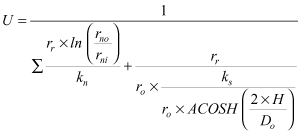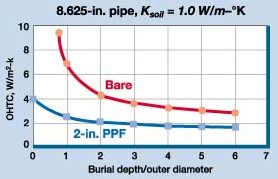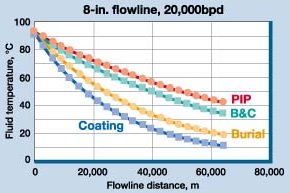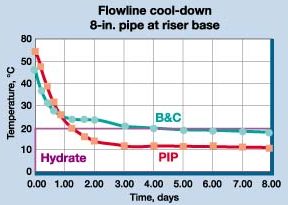Deepwater soil thermally insulates buried flowlines
TECHNOLOGY UPDATEDeepwater soil thermally insulates buried flowlinesAnalyses, lab work indicate potential for cost savings by burying bare or coated pipe vs. pipe-in-pipeKenneth J. Loch, Stolt Offshore Inc.,* Houston, Texas
The estimated potential savings for buried and / or buried and coated (B&C) over PIP for deepwater flowlines in a typical project is about $10 million to $30 million, depending on flowline size, length and water depth. Another benefit of B&C systems is their realistic repair scenarios, compared to deepwater PIP systems which are difficult, if not impossible, to repair with existing technology. Background Heat flow through soil for buried oil / gas flowlines can be attributed to a combination of heat-loss mechanisms, namely:
However, for typical flowlines, heat loss from radiation and micro and macro distillation in soils is relatively insignificant compared with the heat loss from conduction and convection (Winterkorn and Fang, 1975). Therefore, soil conduction and convection heat losses will be solely considered here. In addition, if the fluid of concern contains a non-ideal gas, the fluid can have a temperature drop due to the Joule-Thompson effect. Global Joule-Thompson effects in oil / gas flowlines are primarily caused by pressure-head changes, which are predominantly experienced in the flowline riser. The focus here is on the thermal benefits of flowline burial relative to other commonly available flowline insulation systems. Joule-Thompson cooling is relatively independent of flowline insulation options and does not change the relative thermal benefits of different insulation systems. Thus, the Joule-Thompson effect will not be explicitly discussed here other than noting that its effects are implicitly included in some of the numerical results. Heat Flow The methods and equations for calculating radial heat flow for normally insulated and buried flowlines can be found in many standard texts and published papers (Colquhoun and Nielsen, 1998). The basic equation for heat loss along a unit length of pipe can be expressed as:
where A is a reference area defined by a reference radius and a unit length of pipe. The overall heat transfer coefficient, or U value, is the inverse of the cross-section’s thermal resistivity and comprises three primary resistances: internal film, external film and radial material conductance (Colquhoun and Nielsen, 1998). For even nominally insulated flowlines, thermal coating and / or burial provide an order of magnitude more thermal resistance than both internal and external film coefficients. Hence, for all practical subsea flowline applications, external coatings and / or burial will almost exclusively determine the thermal properties of the flowline system. Ignoring the internal and external film coefficients, the overall heat transfer coefficient (OHTC) of a flowline can be described as:
where the first term in the denominator represents the thermal resistance of the radial layers of steel and coatings, and the second term in the denominator represents the thermal resistivity afforded by the soil and is valid for H > Do/2. If the internal and external film coefficients are to be included, the external film coefficient is usually only included for non-buried flowlines. Fig. 1 presents the relationship between OHTC and burial depth. Burial depths between three and five times the total flowline outer diameter provide the majority of the available soil thermal insulation. Thus, it is not necessary to bury the flowline to a great depth to provide significant thermal benefits. However, there are practical minimum and maximum burial depth limitations using modern flowline burial techniques. In addition, issues such as potential seafloor scouring and flowline upheaval buckling need to be considered in designing the appropriate flowline burial depth.
Soil Thermal Conductivity OHTC varies linearly with soil thermal conductivity (Eq. 2). The slope of the OHTC-to-ksoil relationship depends on the percentage of the total thermal insulation derived from the soil. For buried bare flowlines, where the soil provides essentially all the flowline’s thermal insulation, there is a near one-to-one relationship between OHTC and ksoil. For buried and coated flowlines, the OHTC-to-ksoil relationship also is linear, but less than one-to-one. Recent studies by Stolt have shown that the soil thermal conductivity for deepwater Gulf of Mexico (GOM) clays is approximately 1.0 W/m – °K. As a comparison, still seawater has a thermal conductivity of approximately 0.65 W/m – °K. The soil thermal conductivity value is much lower than that previously published for general soils and, until recently, there has been little or no published thermal conductivity data for soils similar to those found in the deepwater GOM. Soils in some other deepwater regions have similar soil parameters as those in GOM. Therefore, there is a high likelihood that deepwater soils in offshore regions such as West Africa and Brazil will have similar insulating properties. The soil and water around a buried flowline must remain still to avoid convection-heat losses in addition to radial-convection losses. Soil samples from deepwater GOM sites indicate a low probability for thermal convection. Steady-State Insulation Performance State-of-the-practice methods for insulating flowlines include external coatings, flowline burial and pipe-in-pipe. Other methods exist for keeping production fluids above their wax appearance and/or hydrate formation temperatures, such as electrical heating and hot water annulus. However most of these other heating methods have not been field tested and / or require active power sources. Table 1 presents the OHTC for various pipe size and insulation system combinations. Bare pipe has little resistance to heat loss. However, burying bare pipe is equivalent to adding approximately 60 mm of low conductivity external coating. Combining burial and coating achieves OHTC values near those of pipe-in-pipe. If lower soil thermal conductivity and / or thicker external coatings are used, the B&C system could achieve the same OHTC as typical PIP. Considering realistic fabrication and installation limitations, PIP can always be designed to have a lower OHTC than B&C. However, the fully installed costs of equivalent PIP systems are estimated to be more than double those of B&C systems. In addition to the OHTC, the fluid temperature change along a flowline is dependent on the fluid’s specific heat, Cp, its mass flowrate and the ambient temperature. Both Cp and density are functions of pressure and / or temperature, and ambient temperature can change with location. Therefore, steady-state flowline temperatures normally are determined using iterative nodal analysis tools such as PipeSim (BJA, 1999b). Fig. 2 shows the temperature along a horizontal flowline for different insulation systems. Note again that burial alone provides greater thermal insulation than significant amounts of low conductivity external coating and that – when combined with coatings – buried systems have steady-state thermal performance near that of PIP.
Transient Insulation Performance While steady-state performance (flowing outlet temperature) is generally the primary metric for thermal-insulation design, transient cool-down rates are also important, especially when hydrate formation is possible. Without sufficient cool-down rates, most hydrate-prone production systems require constant injection of hydrate inhibitor or flowline flushing systems using dead oil or methanol. Such hydrate inhibition systems are both costly and require reliable, active infrastructure. Fig. 3 presents the transient cool-down behavior at the end of a 27-km flowline. For the case presented in Fig. 3, the PIP flowline had a slightly lower OHTC than that of the B&C flowline. Hence, the steady-state temperature at the base of the riser is slightly higher for the PIP than the B&C system, 56°C for PIP and 47°C for B&C. These steady-state temperatures are the initial temperatures at the start of a transient shutdown. Due to its slightly higher starting temperature, the PIP system initially has longer cool-down rates than B&C. However, the B&C system quickly surpasses the PIP system and provides much longer cool-down times in the region of typical hydrate formation.
For the case considered, B&C had approximately three times the cool-down duration of PIP before hydrate formation: 1.2 days for PIP and 4.0 days for B&C. The extra time available before hydrate formation has significant financial implications for offshore operations, such as reduced chemical injection, reduced line flushing and reduced topsides equipment. The transient startup performance for both B&C and PIP is similar but reversed to the cool-down performance shown in Fig. 3. Therefore, both systems will heat up above their hydrate formation and wax appearance temperatures relatively quickly, but the rate of temperature change will decrease as the flowing temperatures approach their final steady-state flowing condition. Burial’s Financial Implications Burying bare pipe provides the insulation equivalent of more than 60 mm of low-conductivity external flowline coating at about half the cost. Burying coated flowlines can provide thermal performance close to that of PIP at roughly half the cost. There is a further benefit: B&C systems have realistic repair potential. In contrast, deepwater PIP systems are difficult, if not impossible, to repair using existing technology. Conclusions, Recommendations Flowline burial has significant thermal benefits. Burial alone or in combination with external coatings can provide desirable steady-state outlet temperatures and significantly increased cool-down rates. Successful flowline burial has recently been achieved in the GOM providing confidence to those seeking alternatives to more costly insulation options. While much analysis and laboratory work has been completed in the area of flowline burial, there is little available field data. It is recommended that in situ soil thermal conductivity tests be performed to determine if soil thermal conductivity is pressure sensitive or in any other way different from lab measurements. Also, flowing outlet temperature should be measured on a buried deepwater line during steady-state and, if possible, start-up to verify that the available analytical tools can predict true field behavior. DWT Acknowledgment The author acknowledges Alan Young of MARSCO Inc. and Richard Shea of ScandPower Inc. for their input to and review of the paper on which this article is based. Nomenclature
|
|||||||||||||||||||||||||||||||||||||||||||||||||||||||||||||||||||||||||||||||||||||||||||||||||||||||||








